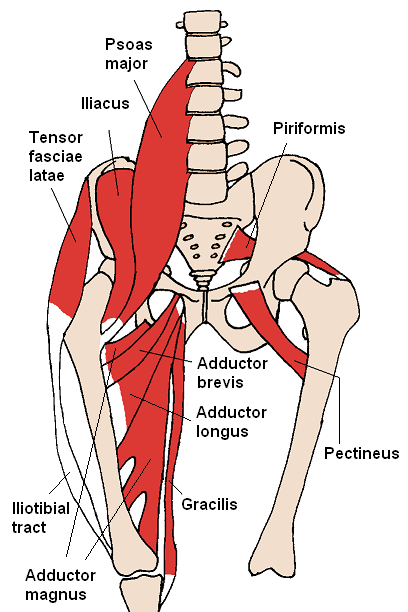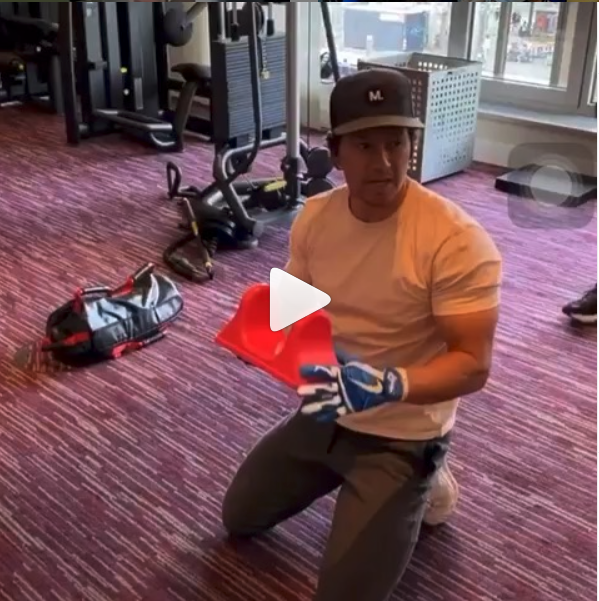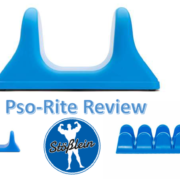PSO-RITE (affiliate link) is a u-shaped device designed for working on your psoas muscles. In this article I will cover a holistic view on this topic and you will gain information about where the M. psoas is located, why some people consider it to be the “soul muscle” and how you can use the PSO-RITE properly. We will also discuss the PSO-RITE’s “siblings”, the PSO-SPINE and the PSO-MINI! I invite you to join me on this “lovely dance” we’re going to perform on our journey to the “power psoas”. Hopefully, I can help you to unlock your full potential by guiding you through some psoas exercises and some spiritual impulses concerning this “miraculous” muscle.
Let’s begin…
PSO-RITE – hidden like the “dark knight”
I really like to use a little pun here and there, to give the benevolent reader a more sophisticated reading experience. The pun in the header (dark knight) is referred to the “dark knight”, better known as Batman, just in case you wondered 😉
This pun, though, has a particular reason. I chose it as the M. psoas major is really “hidden” deep inside us. It’s a muscle that cannot be seen superficially nor is it easy to be touched!
To be precise it “(…)is a long fusiform muscle located in the lateral lumbar region between the vertebral column and the brim of the lesser pelvis. It joins the iliacus muscle to form the iliopsoas. In animals, this muscle is equivalent to the tenderloin.” (Wikipedia, 2020)
But what does “psoas” actually mean and where does it come from? Well, the term psoas derives from Greek psoa = “meat of the loin”, respectively “muscle of the lumbar region” (Becher et al., 1995).
Now that we know where the medical term originates, we’ll take a look of what the psoas is supposed to do, again from an anatomical/school medical point of view.
Again, our first approach is Mr. “know-it all”, aka Wikipedia. There you will find the following:
„The psoas major joins the upper body and the lower body, the axial to the appendicular skeleton, the inside to the outside, and the back to the front. As part of the iliopsoas, psoas major contributes to flexion in the hip joint. On the lumbar spine, unilateral contraction bends the trunk laterally, while bilateral contraction raises the trunk from its supine position. In addition, attachment to the lesser trochanter, located on the postero-medial aspect of the femur, causes lateral rotation and weak adduction of the hip. It forms part of a group of muscles called the hip flexors, whose action is primarily to lift the upper leg towards the body when the body is fixed or to pull the body towards the leg when the leg is fixed.” (Wikipedia).
Sounds fancy, right? But what does it mean? Well, let’s take a closer look and decrypt the most important of these medical terms.
First, ap/pendicular derives from Latin pendere = to hang, to hag, to sag (Becher et al., 1995).
The ilio/psoas is the combination of the Latin prefix ili(o) = “belonging to the iliac bone” and the aforementioned psoas (Becher et al., 1995). Therefore the ilio/psoas is a more or less grown together of two muscles, the M. iliacus and the M. psoa becoming the: Ili(o)psoas.
How much these muscles are grown together differs from human to human.

The picture above will give you a quite good example of how tight/narrow the Iliacus and the Psoas Major are located plus that they are often, at least partially, grown together.
Due to reasons of volume we will keep the other displayed anterior hip muscles aside, as we’ll focus on the psoas and keep the anatomical excurse to a minimal effective dosage 😉
Just bear in mind that on top of the displayed muscles in the image above you also have different layers of abdominal muscles. That’s why it is rather hard to “get in touch” with your psoas.
As one of the major anatomical functions of the psoas is to perform a hip flexion it should be no wonder why it is often to be found too tight!
When you enter this realm, which we call earth, respectively reality, you are born into flexion. According to that, you are struggling, literally from day one to work against that. In a physical, as well as in a spiritual and psychological manner.
Just think of the English word “live” spelled backwards…take all the time you need 😉
You have to develop a proper posture, your own conscious mind and you must fight against extensive inward rotation due to prone sitting, driving, “smart phone posture” etc., you get the point.
If you want to learn more about the importance of posture and what a “proper posture” is considered to be, you may read my articles:
· POSTUREPRO BRAIN COACH PERFORMANCE CERTIFICATION REVIEW
· ALIGNMENT FROM 🗣️ HEAD TO TOES 👣
· FREO FOOT CARE SYSTEM REVIEW
It is not uncommon that the Psoas is part of something called: “lower cross syndrome”. An “issue in the tissue”, and posture, that will result in an anterior pelvic tilt, a too tight (ilio)psoas, a crosswise tight erector spinae and, on the other “cross” too weak abdominals and too weak gluteus maximus.
When I write: “it is rather hard to “get in touch” with your psoas”, do you know what a great kind of transition that is?
Well in a couple of minutes I’ll hopefully contribute to your enlightenment.
PSO-RITE – Are you emotionally tight?
Speaking of the psoas you now got a glimpse of what this “bad boy” is capable of doing, at least from an anatomical point of view. Now let’s ascend and experience the psoas from a total different perspective, a spiritual one!
Can you think of muscles in a spiritual sense?! Sure, why not?
According to Liz Koch’s amazing work, the psoas is far more than a core stabilizer and/or a hip flexor muscle!
It is an “organ” of perception composed of bio-intelligent tissue and “literally embodies our deepest urge for survival, and more profoundly, our elemental desire to flourish.”
Furthermore, Koch and others have contributed to the view of the psoas as influencer to your (emotional) health, state of being and vitality.
In Yoga the psoas even is considered to be the “muscle of the soul”. Is it that absurd to think of a too tight (ilio)psoas being the result of a chronically (over) stimulated sympathic nervous system?
I wonder if a tight psoas does not only contribute to faulty posture and restricted movement patterns but ultimately reflects a “tightened” soul? Does the body function as kind of ultra-dense signal transmitter of your soul?
Would a release of a tight psoas help in “calming” your sympathic nervous system? Resulting in a physical AND psychical/spiritual release?
I keep this open for debate and your constructive comments below this article. Please feel free to share your ideas about that approach!
Apropos, the psoas is, by all means, not the only muscle associated with your soul! The ancient Greek belief was that what we call “the soul” was also to be found within your dia/phragm. That’s what the term schizo/phrenic derives from!
As the belief goes your dia/phragm inheres your soul. Let’s use another brief decryption of those Latin, respectively Greek terms to see what that “fuzz” is all about.
The term dia/phragm is a combination of the Latin prefix dia = through and the suffix phragma, respectively Greek diaphragma = “partion wall” (Becher et al., 1995).
Moreover, diaphragm and phren describe the same muscle, on the one hand you have Latin (diaphragm) and on the other you have the Greek term = phren (Becher et al., 1995).
In addition to that, you have another Greek term: schizein = to split, to divide (Becher et al., 1995).
Now, let’s connect schizein with phren and, voila you get: schizo/phrenic, which exactly describes what it is supposed to be: a divided/split apart personality, respectively soul!
Concerning the psoas and its “soul connection” I highly recommend you to read the books of Liz Koch, especially:
PSO-RITE – How to use it
Let’s take a look at the PSO-RITE device and how it works. It’s a specially designed, u-shaped device. Simple to describe but not always easy to use!
In the video below I show you a brief demonstration of how the PSO-RITE is supposed to work:
In case you want to skip the video, here’s my short manual:
- Place the PSO-RITE on a non-slipping surface
- Locate the location of your (ilio)psoas (take a look at the picture above)
- Lay on the PSO-RITE, resting on your forearms
- Just get a gentle feeling of the PSO-RITE “diving” into your tissue
- Take your time and get used to the feeling, there’s no need to hurry!
- Breath out and let the PSO-RITE sink in further
- If you feel any pain immediately stop the exercise!
- If you feel comfortable you might lower your upper body to the ground (keep your palms besides you, this will help you getting up more easy)
- Try to gently move up and down as well as side-to-side with your hips
- Limit the hold of a position to a max of 60 sec. until you get more experienced
PSO-RITE – When to use it?
Now that you have an idea HOW the PSO-RITE is supposed to be used the question arises WHEN do you best use it. Well, of course, this question has to be answered with: “it depends”.
It depends on how severe your “issue in the tissue” is. If you suffer from any pathologies like the aforementioned “upper cross syndrome” i.e. you might use it more frequently than someone with pretty good psoas flexibility.
Please, also keep in mind that a manipulation of the psoas might also contribute to a release of your emotional “traps” or at least might release constant stress by “freeing” you from a chronic state of being in “Fight- or Flight” mode!
This is only my opinion and I did not come up with that, but from a holistical point of view it makes total sense! Just don’t take my words for granted, do your own research and see if all this makes sense to YOU!
PSO-SPINE – Feeling fine?
The PSO-SPINE company didn’t stop with thinking of the psoas, they also came up with another “cool tool”, called the PSO-SPINE!
Basically it’s the opposite approach of the PSO-RITE, as its intention is to work the back muscles, especially those around your spine.
I highly recommend you to invest in the total bundle. The PSO-RITE, the PSO-SPINE and the PSO-MINI. Just because I think that you always have to see the “bigger picture”.
It doesn’t stop with just treating a too “tight” psoas. Not from a physiological, nor from a psychological/spiritual point of view. You should incorporate “the whole thing”.
According to that, it ultimately makes sense for me that “issue in the tissue” (tight erector spinae) can also be some unsolved emotional problems and/or the result of faulty movement patterns.
Therefore having the right “tools” in your “health tool box” will enhance your possibilities of working on your problems.
PSO-MINI – The all-rounder?
The PSO-MINI is not round, but it seems to be the most versatile of the three PSO-RITE products. With the other ones being specialists, the PSO-MINI is the “all-rounder”.
Due to its rather small size, firmness and shape, its strength lies in its miscellaneous usability.
I use it for working on trigger points. That’s where I see the PSO-MINI’s biggest advantage. But, again, that’s only my opinion.
Do you have special issues you could solve with this tool? I’d be happy if you share it with me and the readers of this article!
Hollywood actor Mark Wahlberg also seems to be a fan of the PSO-RITE (see picture), as well as famous Podcast-host Joe Rogan.

PSO-RITE REVIEW CONCLUSION
In the end you always want to know whether something is only an expense or an investment.
To make a long story short: the tools of the PSO-RITE family are a great investment, speaking from my own experience!
By the way, otherwise I would not have taken the time (as time is a kind of “energy-currency”, too) to write a whole article. I’m not that kind of human who invests time in something he doesn’t like and takes even more time telling other people why he dislikes it so much…
Thinking of the psoas as “the soul muscle” is a lovely approach that really fits well into my understanding of what we tend to call “world”, as I also work as a “Heilpraktiker” (complementary and alternative medicine practitioner).
I incorporated the PSO-RITE and the other mentioned tools into my daily routine as well as in the work with my patients and clients.
Hopefully this article contributes to your decision whether to invest in these “cool tools” in a positive manner.
Thanks for taking your precious time and reading my article, much appreciated!
I wish you an energetic time, see you soon!
© HP Bernd Stößlein, Master of Business Administration in Sportmanagement.
If you liked this article please share it with your friends, subscribe to the newsletter and the blog.
If you like to book a professional online/offline consultation please feel free to contact me:
Literature
Psoas major muscle, source: https://en.wikipedia.org/wiki/Psoas_major_muscle, access from 11.8.20.
Lateinisch-griechischer Wortschatz in der Medizin, S. 68.
Lateinisch-griechischer Wortschatz in der Medizin, S. 161.
Lateinisch-griechischer Wortschatz in der Medizin, S. 167.
Lateinisch-griechischer Wortschatz in der Medizin, S. 181.
Lateinisch-griechischer Wortschatz in der Medizin, S. 196.


